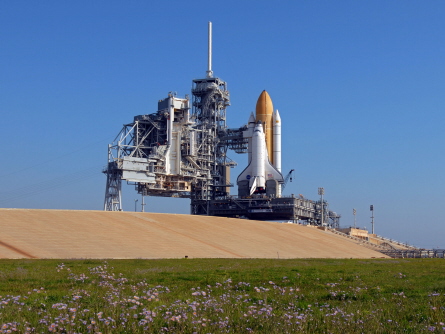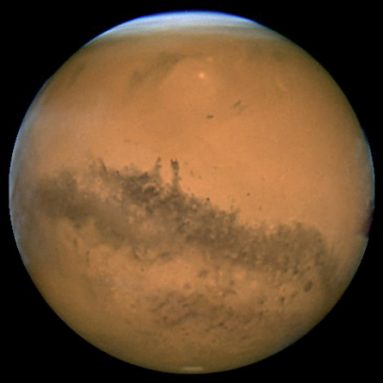Planning for Mars
Obama outlines space program that would take crew beyond the moon.
By Stephen Ornes
Forget the moon: We’re headed to Mars.
That’s one message President Obama delivered on April 15, during a speech about the future of the U.S. space program. The president’s plans do not involve a return trip to the moon, which humans have not visited since 1972. But they do include a trip to an asteroid and, eventually, to Mars.
Obama spoke at NASA’s Kennedy Space Center near Orlando, Fla., which is where space shuttles blast off (on the back of powerful rockets) and often land. Space shuttles carry astronauts and scientists into space, but the space shuttles will no longer be used after this year. Obama’s speech was important because he talked about what will happen after the shuttles are retired.
 |
|
The space shuttle Atlantis waits on the launch pad for mission STS-132. NASA’s Space Shuttle program has been carrying people into space since 1981, but is about to end.
|
| Jim Grossmann/NASA |
“No one is more committed to human exploration of space, to manned space flight, than I am,” Obama said to the crowd, “but we’ve got to do it in a smart way.” (Hear excerpts from Obama’s speech.)
The new plan for space exploration includes many changes. It cancels a program called Constellation, which was introduced by President George W. Bush. Under the Constellation program, scientists would have built powerful new rockets to take humans to the moon. Under to the new plan, the next generation of rockets will launch to carry humans far beyond the moon.
 |
|
The new plan aims to get crewed shuttles to Mars by the mid-2030s. This 2005 image shows the planet as its orbit took it relatively close to Earth.
|
| NASA Hubble Space Telescope Collection |
Obama spoke of getting human beings to an asteroid in the year 2025, and to Mars about 10 years after that. By the mid-2030s, he said, spacecraft carrying crew would be landing on Mars.
The Constellation program also included plans for a ship called Orion, which can carry people. Orion was not canceled in the new plan.
One of the most important changes to the space program involves money. In President Obama’s plan, NASA will get $6 billion over the next five years. That money, however, will be spent on new technologies, not on the development of the powerful rockets that we’ll need to get to Mars.
Instead, the new plan calls for private companies to create and build the rockets and spacecraft that can carry people and supplies into space. Obama hopes that companies who compete for the business of flying people into space will find a cheaper way to do it.
“The real key in all of this is the ability of the private sector to do what NASA has been unable to do for about the last 30 years, and that is cut the cost to low Earth orbit. As long as NASA was spending $4 billion to $5 billion a year flying the space shuttle, [the agency] was going nowhere,” Howard McCurdy told Science News. McCurdy studies government policies related to space at the American University in Washington, D.C.
Some critics say Obama’s plan is too risky and not specific enough — after all, companies may not find a way to get people into space. Other scientists applaud the pfresident’s effort to energize the space program.
“I am very happy about the introduction of new innovative commercial approaches in human space flight,” Alan Stern told Science News. Stern is a planetary scientist at the Southwest Research Institute in Boulder, Colo., and used to work for NASA.
Going Deeper:
* Cowen, Ron. 2010. “Not your grandfather’s space program,” Science News, May 8. http://www.sciencenews.org/view/generic/id/58338/title/Not_your_grandfathers_space_program
Learn more about NASA’s transition into the new plan here: http://www.nasa.gov/mission_pages/transition/home/index.html
Watch videos of astronauts, space shuttles and the International Space Station on NASA TV: http://www.nasa.gov/multimedia/nasatv/index.html







